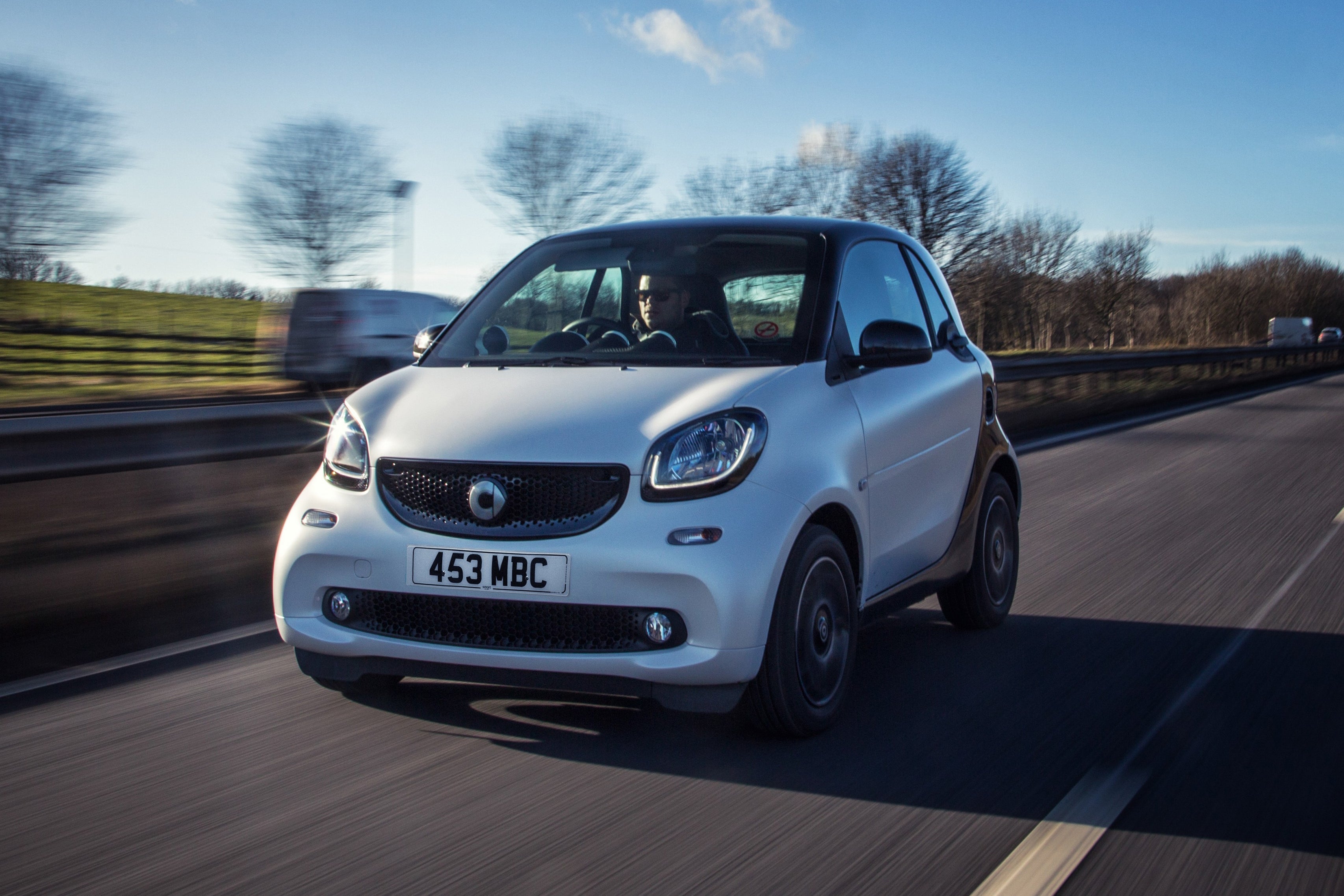Smart Fortwo (2014-2019) Review
Written by Andrew Brady
Quick overview
Pros
- Tiny dimensions make for easy parking and city life
- Good standard specification and quality feel
- Low running costs
Cons
- Expensive to buy
- Indifferent ride quality and flawed handling
- Two seats only
Overall verdict on the Smart Fortwo Coupe
"In this Smart Fortwo Coupe review we are looking at one of the smallest cars ever to reach production - it's more than 300mm shorter than an original Mini - and yet as a city car it arguably makes more sense than ever. Its tiny dimensions are both a strength and a weakness, and on many aspects it struggles to compete with more conventional rivals. However, get it on its home turf and it's hard to beat. It also makes a lot of sense as a used purchase, with high new prices being one of the biggest hurdles."
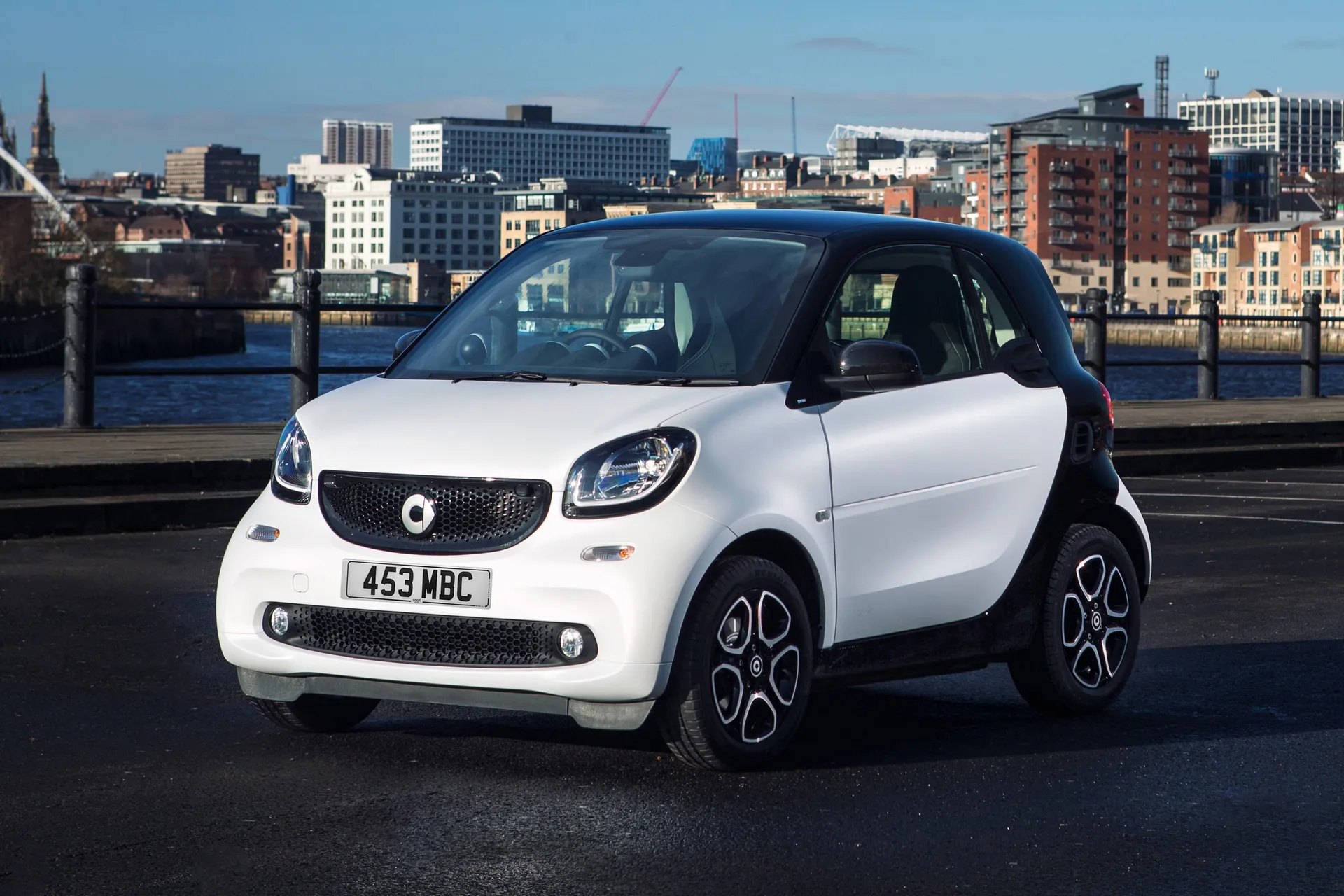
Originally conceived by Swatch - yes, the people who make snazzy watches - it became a joint project with Mercedes-Benz and eventually came to fruition in 1998 as the Smart City Coupe.
The most recent version of the Smart Fortwo was introduced in 2014, and retains the key elements that make it such an intriguing car. Firstly, it is quite comfortably the smallest car on sale today - at 2695mm long, it is almost 1.5 metres shorter than a Ford Fiesta. It’s quite wide and tall given its length, and is a strict two-seater.
Designed to be the ultimate city car by virtue of its size, the Smart Fortwo has a rear-mounted engine that sits beneath the boot floor and sends power to the rear wheels - both of which are quite unusual features in modern cars. All models are fitted with a three cylinder turbocharged engine, with varying outputs depending on the model and trim.
On first acquaintances it can take a little while to understand the Smart Fortwo from the outside. Its proportions are unlike anything else on the road, with almost no overhangs front and rear, a very short bonnet and a vertical rear. Not that it is without some sense of style though - the Smart goes big on personality and there are numerous colour combinations to distinguish it further from more conventional cars.
There’s also the small matter of the Smart Fortwo’s bodystyle. You can have a Smart Fortwo as a Coupe or a Cabriolet - we have a separate review for the Cabriolet - which is technically accurate because there is a single door on each side of the car and not two - but at the rear you get a split tailgate, with the top glass half that lifts up and the bottom half that drops down like you get on a pick-up. You could argue it’s more of an estate than a coupe, but that would be ridiculous...
Get inside and the acclimatisation continues, as the Smart Fortwo Coupe is unlike any other car you will have experienced before. Whether you’re a driver or passenger, you sit higher up than in most cars, which is good for improving your view out. Understandably, with a car small enough that you can almost touch all four corners from the driver’s seat, it’s easy to judge where the car’s extremities are.
The Smart Fortwo’s Coupe driving experience is something of a mixed bag. In some respects it is way ahead of everything else. Its size allows you to do things you can’t in any other car, with a super-tight turning circle and excellent manoeuvrability.
The turbocharged engine is also pretty fizzy, especially the more powerful 90PS version, making it eager in town. On the downside, the ultra-short wheelbase and relatively stiff suspension means the ride quality is poor on some surfaces, and although it never feels like it is going to tip over, its height and the amount of bodyroll during cornering can chip away at the driver’s confidence.
The Smart Fortwo Coupe is a brilliant concept, but making a car this small brings some compromises with it. In the right circumstances, the Smart Fortwo Coupe is a great city car, but it struggles out of the city and doesn’t instill confidence in the driver like most of its rivals do. If you want a small car with a rounded set of abilities, this isn’t it, but it’s not without appeal or charm.
Looking for a used car for sale? We've got 100s of Smart Approved Used Cars for Sale for you to choose from, including a wide range of Smart Fortwo Coupe models for sale. If you're looking for the EV version, you need our Smart EQ Fortwo review.
Is the Smart Fortwo right for you?
If you plan to spend most of your time in the city and never have more than a single passenger, it can zip through traffic and park more easily than any rival - there’s some legal doubt on the matter but you can physically park a Smart Fortwo Coupe rear-in to the kerb, it’s that short - which makes it an obvious choice for a city dweller.
Unlike some of its city car rivals however, the Smart Fortwo Coupe is less capable outside of the city, and the fact it is a two-seater means it will hardly work for many families either. The Smart Fortwo is also not a car well suited to novice drivers, with its slightly unusual handling characteristics.
What’s the best Smart Fortwo Coupe model to choose?
Although the basic 71PS engine option works well enough in town, it doesn’t take long for it to become a little breathless on quicker roads, and even if that isn’t very often it can be frustrating making decent progress. We’d suggest choosing a model with the more powerful 90PS engine. The Brabus model has 109PS, but is much more expensive and comes with its own set of issues, so we’d give that a miss too.
As the Smart Fortwo Coupe was sold as premium small car rather than a cut-price special, the standard specification is actually pretty strong. Passion models come with alloy wheels, climate control and Bluetooth, which will be enough for a lot of buyers. The mid-spec Prime is a good choice though, as it adds leather trim, heated seats and lane keep assist.
What other cars are similar to the Smart Fortwo Coupe?
In many respects there are no other cars like the Smart Fortwo Coupe. The only car that comes close to it in terms of size is the Toyota iQ, but in terms of being semi-premium city car it is closer to things like the Fiat 500.
For similar or even less money you could find good examples of the Toyota Aygo, Peugeot 108 and Citroen C1 siblings, all of which offer more space and similar running costs, if not the same level of style and quality. Alternatively, you could go for a Volkswagen Up and get a better standard of interior finish and quality and still enjoy the extra space for passengers.
Comfort and design: Smart ForTwo Coupe interior
"One look at the Smart Fortwo Coupe from the outside and you’d’ be forgiven for thinking it would be as comfortable as a phonebox, but thankfully it’s a lot better than that."
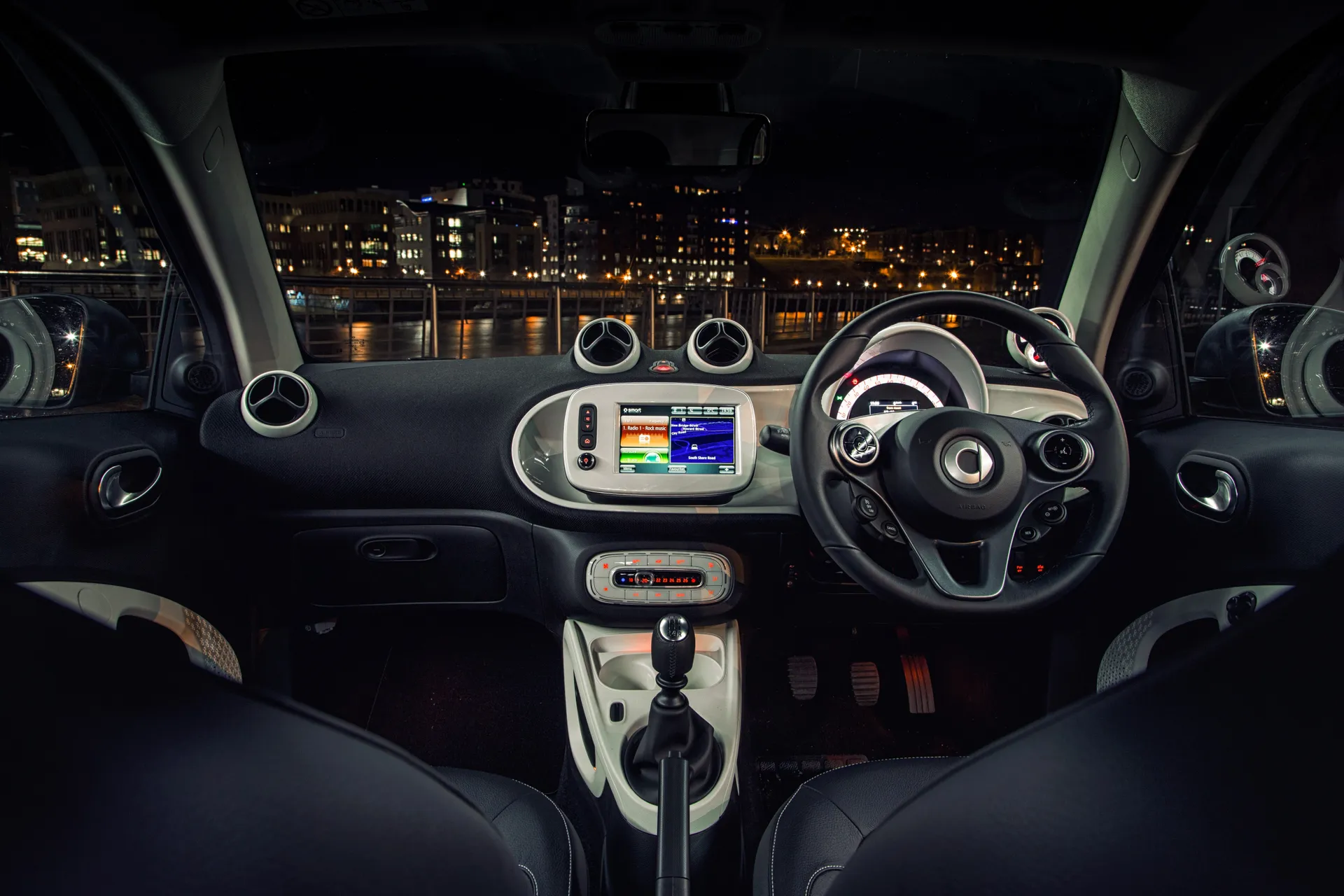
The single door on each side is relatively big, opening wide to give you easy access to the seats. As it’s so tall, you almost step across into it rather than having to sit down, which is a bonus if you’re less able-bodied.
The driving position is also quite high-set, but that helps visibility - it’s easy to see out and you can judge the car’s extremities easily, although the over the shoulder view is hampered by the thickness of the rear pillar.
You get seat height adjustment as standard, and the steering wheel adjusts for height too, so most people should be able to find a decent driving position. The wheel doesn’t adjust for reach, but that’s true for almost all its rivals too. It can feel a little odd being behind the wheel at first, given the unusual proportions, but comfort shouldn’t be beyond anyone.
The interior design might not be quite as wacky as the outside, but they’ve given it a good go. It’s a riot of curves in here, with a giant central speedometer, some instruments stuck on top of the dash in separate pods (depending on the model) and the dashboard itself is covered in fabric rather than plastic.
If that sounds like an ergonomic nightmare then rest assured, despite the engineered lunacy it all actually works pretty well.
Quality and finish
The Smart Fortwo Coupe is sold as a premium product - semi-premium at least - and while it’s not posh enough to be sold wearing the three-pointed star of a Mercedes, it is still pitched as something a cut above the more commonplace brands.
It manages to justify this billing, at least partly, because there are some nice touches dotted around the cabin and it feels mostly of good quality too. Even if you go for a basic version in Passion trim, it gives off the vibes of a quality product.
There are a mixture of materials and finishes, like gloss black details contrasting with the fabric covering on the dashboard, all of which lift the Smart Fortwo Coupe above the humdrum. It’s also worth seeking out a car that’s had a bit of colour injected into it - even on the basic Passion model you could add a coloured trim pack and this helps to boost the appeal of the interior.
It’s not all good news unfortunately, as a bit of poking around reveals that some of the materials in here are actually pretty cheap.
That’s true for every other car in this sector, but this also reflects that the Smart Fortwo Coupe isn’t really a wholly premium product. Smart’s relationship with Renault is also evident (the Smart ForFour and Renault Twingo are sister cars) with the occasional item of Renault switchgear dotted around the cabin.
Infotainment: Touchscreen, USB, nav and stereo in the Smart Fortwo Coupe
The standard infotainment system on the Smart Fortwo Coupe depends on the age of the vehicle as well as the trim you go for. For the earliest 2014 cars, the basic provision is two-speaker FM/AM radio that also includes Bluetooth, so you can stream audio and make telephone calls. This system is adequate, but lacks the ability to use any other audio sources.
From 2016 onward this system included a phone cradle to make it easier to hook up your smartphone, and also introduced the Smart Media System, standard on Passion models but also available as a standalone option or as part of the Premium package.
This adds a 7-inch touchscreen, navigation depending on the model, Android Auto and DAB, and is a significant upgrade. Unfortunately it isn’t compatible with Apple CarPlay, so you’ll have to make do with just the Bluetooth connection if you have an Apple device. Later cars also add a USB connection, so you can charge and stream from your phone at the same time.
When buying a used Smart Fortwo Coupe be sure to check the standard specification as well as any options fitted so you can get the best infotainment provision - a Smart dealer can help you with this if you want to check on a particular car.
Space and practicality: Smart Fortwo Coupe boot space
More so than any other car you can buy, space and practicality are terms relative to the size of the car and what the competition is like. The two occupants of the Smart Fortwo Coupe have a good deal of space to play with - even if you’re tall there’s plenty of headroom, and with no rear seats to interfere with you can slide the fronts back almost as far as you like, giving plenty of legroom too.
Of course, the Smart Fortwo Coupe is a strict two-seater, and as well as the obvious restriction of only allowing you to carry one passenger, it also means that the driver and passenger can’t fully recline their seats should they wish to do so. However, the other side to this is that you can easily reach into the boot should you wish, even if you’re still sat up front.
Storage space in the cabin is also reasonable and similar to that offered on most of its rivals. The glovebox is quite small, but the door pockets are a useful size and there’s a pair of cupholders - clearly you won’t need more than two.
It’s not something you could officially call storage space, but with no one sat behind you it’s easy to stuff items in the space behind the seats, as long as it’s not something that could roll around and cause problems.
As for the boot itself, it offers 260 litres, which is actually more than the Volkswagen Up and its siblings. The two-piece tailgate is also something of a bonus, particularly when you only have a few bags or you’re in a tight parking space - being able to drop items in through the window is very handy.
You even have the ability to fold the front passenger seat to increase the total space - but you only get 350 litres then, which is nothing like as much as you get from rival offerings that have two rows of seats to play with.
The Smart Fortwo Coupe dimensions are 2695mm long, 1893mm wide and 1555mm tall.
Handling and ride quality: What is the Smart Fortwo Coupe like to drive?
"There are few cars in existence that share the unusual proportions of the Smart Fortwo Coupe, and it’s hard not to think that it will topple over at the first sight of a corner given how tall it is."
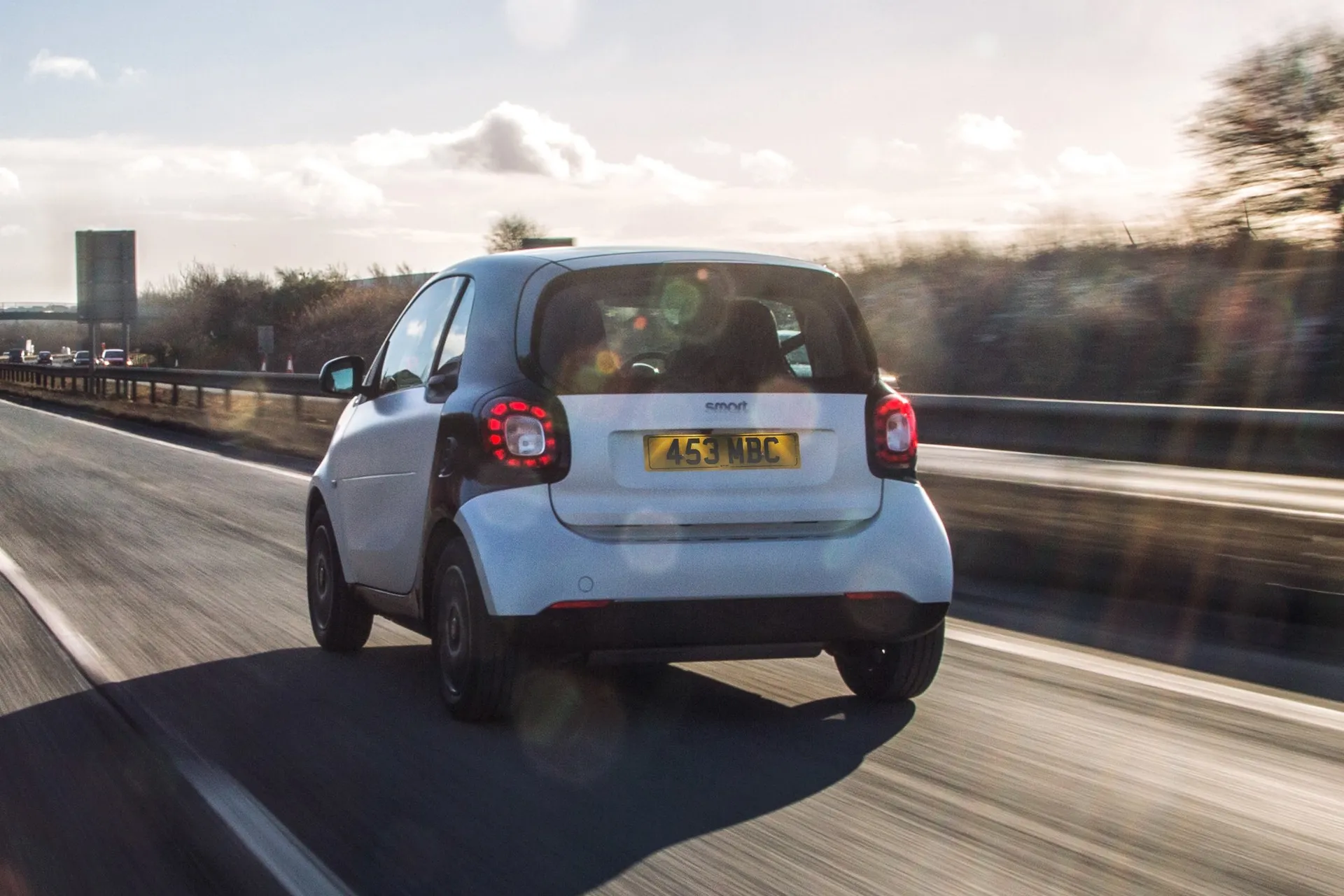
Get behind the wheel and you quickly realise that it is actually stable, and that the quickness of the steering and the short wheelbase means you can change direction with remarkable ease. You can almost feel the car pivoting around you - not least when you go to perform a three-point turn and successfully manage to rotate the vehicle in a single turn.
This is a huge boon in the city and in traffic, where you can park in spaces other cars wouldn’t even slow for.
Out on the open road however it’s not quite as rosy. That same eagerness in the steering and ability to turn quickly feels less natural at higher speeds, and although your brain is telling you this is perfectly safe - and it is - the feeling of being perched up on a bar stool never really goes away. If you like to have a bit of fun in your city car this might not be the one for you.
What doesn’t help matters is the ride quality. It’s more difficult for a car with a short wheelbase to deal with road imperfections, and wheelbases don’t come any shorter than on the Smart Fortwo Coupe.
Because of its length it sometimes feels like you’re being pitched around over larger undulations, while the stiffness of the suspension means it picks out smaller lumps and bumps rather than smoothing them out.
The ride quality isn’t terrible - it’s just quite a bit behind the competition in this respect. Models with sport suspension like the Brabus and some special editions are even worse, so avoid examples with this fitted.
What engines and gearboxes are available in the Smart Fortwo Coupe?
As with most of its competitors, engine choices are relatively limited in the Smart Fortwo Coupe. All models come with three cylinder unit of 1.0-litre or 0.9-litres that is mounted beneath the boot floor. A turbocharger helps to boost both power and efficiency, and given how little it weighs - 890kg for the lightest versions - it doesn’t need much power to offer useful performance.
The basic 71PS model is fine for town use, as the turbocharger boosts the amount of torque available at low revs, making it relatively easy to get away quickly from the lights. It also has the classic three-cylinder sound, with a busy thrum at most engine speeds, but it’s worth noting that the engine is a lot closer to you than it would be in a conventional city car.
Get out of the city and the 71PS version begins to struggle a little, needing to be worked hard in order to keep pace with the traffic. The 109PS version is only available in Brabus trim, and although this adds another level of performance, it’s not really worth the extra expense or the other dynamic compromises that come with it.
Far better is the 90PS version, which also brings an additional 44Nm of torque (taking the total to 135Nm) and has significant impact on the way the Smart Fortwo Coupe drives. Acceleration is significantly more rapid - it actually feels like quite a quick car in this guise - and it’s also far more comfortable at higher speeds, enough to make motorway journeys far more viable.
Smart Fortwo Coupes come with either a five-speed manual gearbox which is perfectly serviceable and works well enough, or a six-speed dual-clutch which is far better than the previous automatic, and has no fuel consumption or emissions penalty either.
Refinement and noise levels
The key issue with the Smart Fortwo Coupe in terms of refinement is once again its size. Because there’s much less car in the first place, you’re closer to all the sources of noise and there’s less space to add dampening that will insulate you from it.
The engine is not what you would call a silent partner - its three cylinder thrum is engaging, but can become wearing if you’re in a hurry and it becomes something of a drone on a long motorway journey.
It’s a similar story in respect of other noise sources. At lower speeds the Smart Fortwo Coupe feels relatively refined, with just a general hum from the engine being the dominating sound. At higher speeds however the rush of tyre roar begins to intrude alongside the whip of wind noise from around the roof and the doors.
You can drown it out with the stereo or just ignore it, but the reality is that most of the competition have an edge on the Smart Fortwo Coupe here. Like with any car purchase, it’s important to try the car in all possible conditions to ensure you’re happy with the way it performs.
Safety equipment: How safe is the Smart Fortwo Coupe?
You’d be forgiven for thinking that a car of the Smart Fortwo Coupe’s size couldn’t possibly be as safe as a conventional car, but Mercedes-Benz put a huge amount of work into its development in order to make it as safe as possible.
Euro NCAP tested the Smart Fortwo Coupe in 2014, and it achieved a remarkable four-star rating overall. It scored 82 per cent for adult protection and 80 per cent for child protection, and only the less impressive scores of 56 per cent for pedestrian mitigation and safety assist rating prevented it from a higher score overall.
As standard, all versions of the Smart Fortwo Coupe come with twin front and side airbags, as well as a knee airbag for the driver, seatbelt pre-tensioners and load-limiters, ISOFIX mounting points for the passenger seat with an airbag cut-off switch, and most importantly ESC as standard.
A useful addition is side wind assist, designed to help you keep the Smart Fortwo Coupe pointing in the right direction in windy days. Higher specification models are also fitted with lane keep assist, but automatic emergency braking was not fitted as standard or available as an option, which is a disappointment on a safety-conscious car.
In terms of other items of equipment, cars fitted with the Premium package get rear parking sensors, while if you opt for a car with Premium Plus this is upgraded to a reversing camera too.
MPG and fuel costs: What does a Smart Fortwo Coupe cost to run?
"Because of its low weight and efficient turbocharged engine, the Smart Fortwo Coupe should prove to be cheap to fuel whichever version you go for."
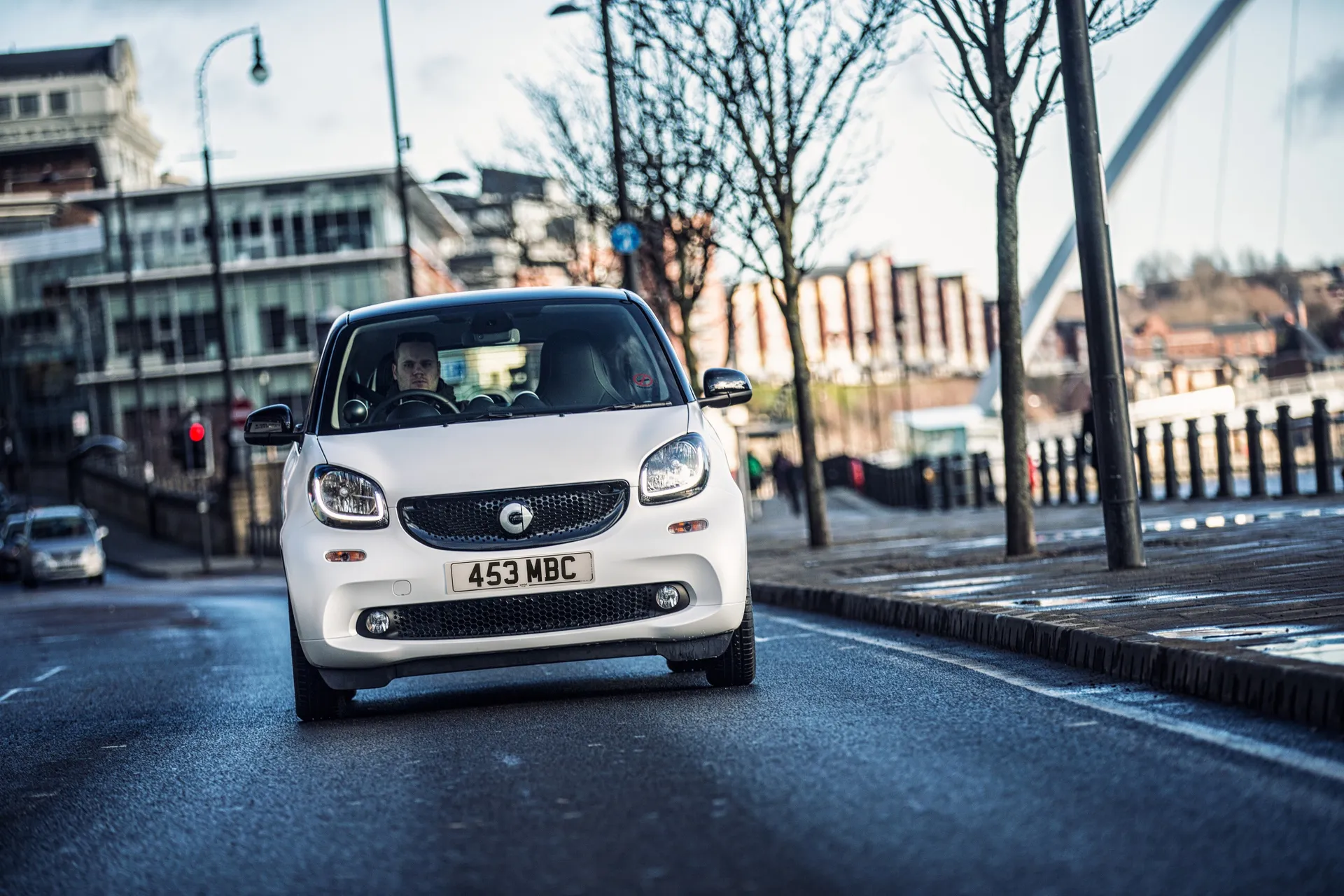
The official combined consumption figure for the Fortwo under the stricter WLTP regulations is between 44.1mpg and 49.6mpg, and unusually it is the higher output 90PS engine and the automatic gearbox that provides the most efficient combination.
Manual gearbox models carry a small penalty compared to the dual-clutch automatic versions, while the lower output 71PS unit may prove to be something of a false economy.
How reliable is a Smart Fortwo Coupe?
The Smart Fortwo didn't feature in the HonestJohn.co.uk Satisfaction Index, but looking at the number of recalls issued for the car it would appear that it offers a decent level of reliability. As always, look for a car with a full dealer service history for maximum peace of mind.
Insurance groups and costs
Insurance groupings for the Fortwo are relatively low, although there is quite a jump depending on the version you go for. Most 71PS models fall into group 2 or 3, the exception being some special editions like the Black, White and Urbanshadow models.
The more powerful 90PS versions are in group 8 or 9, while the top-spec Brabus version is in group 11 or 12 due to its extra performance and price tag. If your budget is tight and you are a higher-risk driver, you may be able to save a significant sum each year if you go for a low-group model.
VED car tax: What is the annual road tax on a Smart Fortwo Coupe?
As the Fortwo is another one of those cars that flirts with the 100g/km CO2 threshold - some are below, some are above - you can pay somewhere between nothing at all and a modest sum depending on what you go for.
All models registered before 1st April 2017 qualify for zero rate VED, with the exception of the Brabus - but even that only costs £20 per year if it’s a pre-April 2017 car. Any car registered on or after that date pays the standard £165 per year rate. If you’re looking at a car around that age, you could save by going for an earlier example.
How much should you be paying for a used Smart Fortwo?
"Ignoring the availability of new Smart Fortwo EQ models (that are electric-only), the most recent petrol-powered Fortwos are still relatively young."
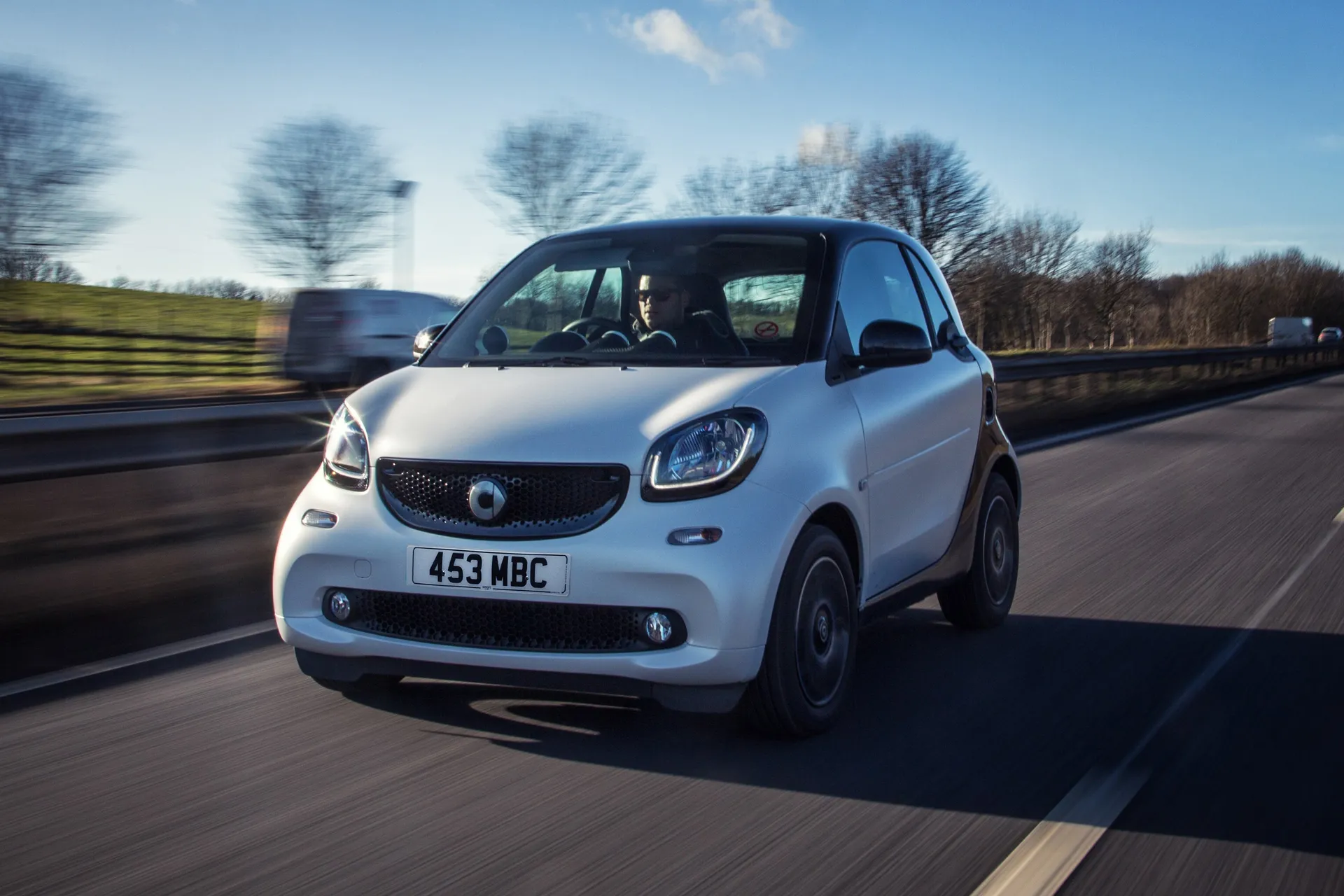
A quick search of the classifieds brought up plenty of 2018-registered models in a variety of specifications. We found a fresh 2018 model in Prime Premium trim with 13,000 miles for just over £11,000, with higher-specification models around £11,000 to £12,000.
At the other end of the scale, the earliest 2014 models are now down towards the £5,000 and falling. We found a 2015 example with 100,000 miles in Passion trim for just under £5,000.
Trim levels and standard equipment
The Smart Fortwo Coupe Pure model is the bottom rung of the range, and because the Fortwo was sold as a more upmarket offering there are relatively few examples on the market. It’s a little light on equipment, although it does come with a height adjustable steering wheel and driver’s seat as standard, something that isn’t fitted to higher-specification versions unless they come with the Comfort pack, so check carefully.
We would suggest choosing one of the mid-range trims such as Smart Fortwo Coupe Passion or Smart Fortwo Coupe Prime, as they add desirable extras such as climate control and parking sensors. It’s also worth considering one of the special editions, as they usually add lots of coloured interior detailing that costs extra on a standard car.
Ask the heycar experts: common questions
Are Smart Fortwo cars reliable?
Why are Smart cars no longer sold?
Why was the Smart Fortwo discontinued?
Get our latest advice, news and offers
Keep me updated by email with the latest advice, news and offers from heycar.
By submitting you agree to our privacy policy
